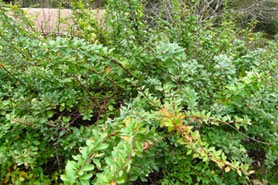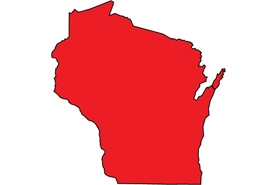Common (European) barberry
(Berberis vulgaris)
A dense, spiny shrub with long arching branches, reaching up to ten feet tall. Plants have 3-pronged thorns at each stem node and small bright red berries.
A similar-looking invasive shrub, Japanese barberry, is now more widespread and abundant.
Other names for this plant include:
- Scientific names: Berberis × ottawaensis (Schneid.), a cross between common barberry and Japanese barberry (B. thunbergerii).
Classification in Wisconsin: Prohibited
- Ecological Threat
-
- This species was once abundant and widespread across the eastern United States; considered invasive as early as the 1700s. Because it is an alternative host to wheat rust pathogen, eradication efforts decreased its abundance on the landscape.
- Shade tolerant, drought-resistant and adaptable to various open and wooded habitats, wetlands, old fields, and disturbed areas.
- It forms dense stands in natural habitats, dominating the forest understory by shading out native plants.
- Spreads vegetatively through rhizomes and horizontal branches that root freely when they touch the ground.
- Birds readily eat and disperse the fruits, resulting in new infestations far from the initial source.
- White-tailed deer avoid browsing barberry, giving it a competitive advantage.
- Very invasive and widespread across the northeast, Great Lakes and the Midwest. Cultivars of a related species, Japanese barberry, are widely planted as ornamentals.
- Identification
-
Leaves & stems: Stems are long and drooping, thus giving the shrubs an arching form. Stem nodes have single or 3-pronged thorns measuring 1-2 cm long. Older plant stems have grey shredding bark. Leaves are simple, alternate and lanceolate or egg-shaped. Leaves turn bright shades of red, orange and purple in fall.
Flowers: Flowers are perfect and yellow with six petals. They occur in drooping clusters of 10-20 flowers.
Fruits & seeds: Bright red berries are oval with 1-3 seeds. Berries persist on the shrubs well into winter.
Roots: Root and rhizome formation are extensive with a mass of fibrous roots. Roots are bright yellow beneath the light-brown outer skin layer. Branches root freely when they come into contact with the ground.
Similar species: Japanese barberry (Berberis thunbergii) is also a non-native invasive (classified as Restricted) and is widely spread across forests of the northeastern United States.
- Control
- Mechanical:
- Plants can be pulled out or dug up, easiest in early spring. Remove all roots and watch for resprouts. Cutting without herbicide will result in resprouting.
- Mow or cut larger plants before seed set if not able to remove the entire plant.
- Prescribed burns in early spring or late fall can effectively kill seedlings. Use this method in fire-adapted communities to prevent the mortality of surrounding desired vegetation.
- Foliar spray with metsulfuron-methyl, triclopyr or glyphosate.
- Adding a penetrating oil can be effective when used as a cut-stump treatment and basal barking.
- Resources
- Sources for content:
- Gucker, Corey L. 2009. Berberis vulgaris. In: Fire Effects Information System, [Online]. U.S. Department of Agriculture, Forest Service, Rocky Mountain Research Station, Fire Sciences Laboratory (Producer). Available: https://www.fs.fed.us/database/feis/plants/shrub/bervul/all.html [2020, February 19].
- Czarapata, Elizabeth; Invasive Plants of the Upper Midwest: an illustrated guide to their identification and control. The University of Wisconsin Press. 2005. Pg. 88-89


